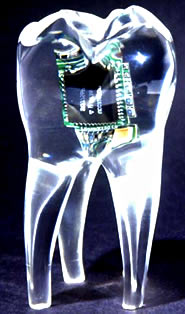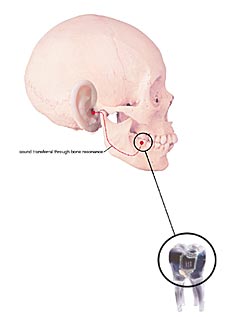|
14
June 2002 - Tooth implant to pick up secret sounds
 A
revolutionary new design for a tooth implant which receives digital signals
from radios and mobile phones will be on show from 21 June until November
at the Science Museum, London. This unique prototype is part of the new
'Future Product' awards, a collaboration between the Science Museum and
the Royal College of Art that is supported by NESTA (the National Endowment
for Science, Technology & the Arts). The awards aim to increase the
public understanding of science, technology and the arts by showcasing
young talent. A
revolutionary new design for a tooth implant which receives digital signals
from radios and mobile phones will be on show from 21 June until November
at the Science Museum, London. This unique prototype is part of the new
'Future Product' awards, a collaboration between the Science Museum and
the Royal College of Art that is supported by NESTA (the National Endowment
for Science, Technology & the Arts). The awards aim to increase the
public understanding of science, technology and the arts by showcasing
young talent.
The tooth implant
was designed by James Auger, from Derby, whose work was chosen from the
Royal College of Art's renowned annual summer exhibition - The Show 2001.
James was helped by fellow Royal College of Art graduate Jimmy Loizeau,
from Rhyl. James and Jimmy have recently joined the Well-Being group at
Media Lab Europe and are continuing their investigations into futuristic
biotechnology, with a particular emphasis on the social implications of
technology.
 The
design builds upon the current form of replacement surgery, such as artificial
joints, to produce the first commodity based in-body product. A micro-vibration
device and a wireless receiver are implanted in the tooth during routine
dental surgery and sound is transferred from the tooth into the inner
ear by bone resonance, converting digital signals to audio. Sound reception
is totally discreet enabling information to be received anywhere and at
anytime, whether it is City traders receiving stock market information
in the cinema or spin-doctors sending information to politicians as they
are interviewed. Sven-Goran Eriksson could keep his customary cool during
a match by issuing instructions to individual players without even having
to raise his voice. The
design builds upon the current form of replacement surgery, such as artificial
joints, to produce the first commodity based in-body product. A micro-vibration
device and a wireless receiver are implanted in the tooth during routine
dental surgery and sound is transferred from the tooth into the inner
ear by bone resonance, converting digital signals to audio. Sound reception
is totally discreet enabling information to be received anywhere and at
anytime, whether it is City traders receiving stock market information
in the cinema or spin-doctors sending information to politicians as they
are interviewed. Sven-Goran Eriksson could keep his customary cool during
a match by issuing instructions to individual players without even having
to raise his voice.
Stories of tooth fillings
acting as receivers to pick up radio signals has long been debated as
a possible urban myth. James' tooth implant design communicates with an
array of digital devices, such as mobile telephones, radio and computers.
Either a mobile phone or a dedicated device is used as the long range
receiver, this can fully customise the users set up to meet their personal
requirements.
James' design is meant
to be a talking point only, exploring the possible social and cultural
impact of in-body technology. This could have the potential to rewrite
Darwinism, as future advantageous mutations will not be random, they will
be chosen by the individual.
NESTA has made an
investment of £15,000 over three years to support the 'Future Product'
display. This will develop opportunities for talented young designers
to share their working practice and approaches to creativity and innovation.
The 'Future Product'
criteria for selection include innovative design, the use of contemporary
technology and a connection to everyday life. Each award winner will work
with the curator, Nick Stewart, to develop their exhibit; this includes
the display of the product as well as interactive displays showing how
the work was developed, for example, original sketches, photographs and
quotes.
Displayed on the ground
floor of the new Wellcome Wing at the Science Museum, the 'Future Product'
forms part of the 'Talking Points' exhibition. 'Talking Points' are a
series of thought-provoking exhibits that engage visitors through an interesting
mix of objects, art works and interactive exhibits spanning the three
disciplines of science, technology and the arts.
|